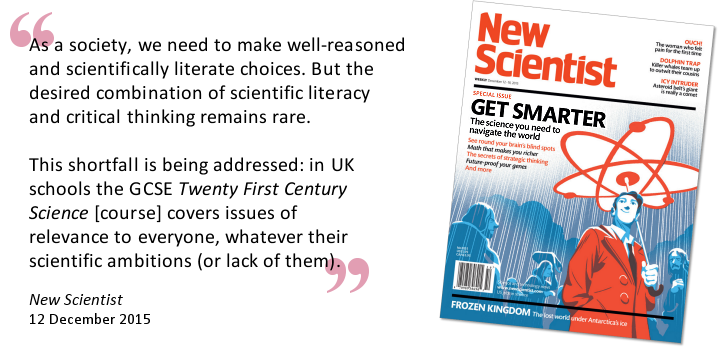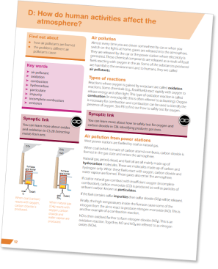Twenty First Century Science: the context-linked approach and developing scientific literacy

We all need to be able to cope with the science that shapes our lives. We are on the receiving end of scientific ideas in our roles as householders, parents, workers, patients and voters. School science needs to equip all students to make informed choices about science.
A minority of young people aspire to become professional scientists or to work in fields where knowledge of science is required. Therefore, educating the next generation of scientific and technical practitioners is also crucial.
Click each question below for information on how Twenty First Century Science can help teachers and students to achieve these aims.
How is Twenty First Century Science different from other GCSE science courses?
From 2016, the content of all GCSE science courses is tightly defined by criteria issued by the DfE. Therefore, you can be assured that Twenty First Century Science covers the same science content as all other GCSE science courses, and that it is a thorough preparation for progression to further study in science.
The difference is in the approach to teaching and learning. Twenty First Century Science links the science to modern and engaging real-world contexts relevant to all students. The relevance of scientific ideas to everyday life is made clear.
In addition, the ‘Ideas about Science’ strand of Twenty First Century Science develops students’ scientific literacy and critical thinking, to help them understand important ideas about how scientists work and how wider society interacts with science. The ‘Ideas about Science’ strand covers ‘Working Scientifically’ and is embedded throughout the course, so understanding is developed within relevant contexts (rather than as a ‘bolt on’), to help ensure it is not neglected.
Twenty First Century Science also tries to live up to its name. In updating the courses for teaching from 2016 we’ve worked with science specialists including the Wellcome Genome Campus, the Food and Environment Research Agency, the Natural History Museum and Solarcentury to ensure we reflect the science that is done in modern research labs and how it impacts society in the 21st century.
How is the context-linked approach implemented?
On the right is an example of a page from the Twenty First Century Science student books.
The page introduces some fundamental concepts in chemistry – oxidation and combustion – within the context of air pollution and how human activities are changing the atmosphere. This is within the broader context of climate change and its impacts, a theme that is explored in the chemistry, physics and biology courses.
Students may struggle to see the relevance of oxidation and combustion reactions per se. Starting with a real-world observation (“the Earth’s average temperature is rising”) and a question (“is this because of human activities?”), and then exploring the science that helps us to answer the question, helps to make the relevance clear.
Does this mean there’ll be more context in the examination papers?
No.
All GCSE science examinations must satisfy three Assessment Objectives in the following proportions, as defined by the regulator Ofqual:
• AO1 – demonstration of knowledge and understanding (40%)
• AO2 – application of knowledge and understanding (40%)
• AO3 – analysis of given information (20%)
AO2 and AO3 can only be assessed in context. This means that 60% of each science GCSE (regardless of which course or awarding body it is from) will require students to apply what they know in context. All examinations from all awarding bodies are limited to 40% direct recall of knowledge and understanding from the specification (AO1), not assessed in context. Any deviation from the above proportions is not allowed, as it would break Ofqual’s rules.
The context-linked approach to teaching and learning in Twenty First Century Science may therefore help students to feel better prepared to apply their knowledge and understanding in context, as they will be required to do in the examinations.
Twenty First Century Science examiners work hard to ensure that our examination papers are accessible, the language is clear, the reading load is minimised, and the level of demand is appropriate. The new specifications and assessments were accredited after an Ofqual comparability study ensured the level of demand of all new GCSE science examination papers from all awarding organisations was the same.
Does the Twenty First Century Science approach make a difference?

In the 12 December 2015 issue, New Scientist magazine explored “the science you need to navigate the world”. This issue opened with an opinion piece that noted scientific literacy and critical thinking as two essential tools with which all school leavers should be equipped. The piece suggested that school science has been lacking in this area, but that Twenty First Century Science is helping to address the shortfall in UK schools.
Rates of progression to post-compulsory science courses are one measure of the impact of GCSE science courses. A survey by Professor Robin Millar of the University of York, published in 2009, showed that schools teaching the Twenty First Century Science GCSE courses experienced increases in the number of students going on to study physics, chemistry or biology at AS-level compared to national averages.
Twenty First Century Science encourages more students to continue the study of science, Millar, 2009 C21 Impact (PDF  , 21kb)
, 21kb)
A larger study by Matt Homer and Jim Ryder of the University of Leeds, published in 2014, saw some small increases in rates of progression from Twenty First Century Science to post-compulsory science courses (compared to progression from other GCSE science courses), including some gender-specific and subject-specific effects, though these were not apparent in all cohorts.

